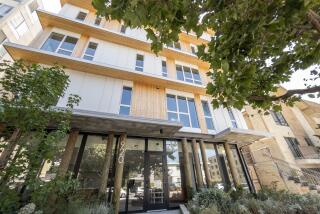Op-Ed: Don’t listen to the backers of Measure S. Los Angeles isn’t overdeveloped; we’re in a housing slump
- Share via
You’ve seen the cranes over Hollywood. You’ve read the stories about new development downtown. If these neighborhoods’ changes are any indication of growth citywide, Los Angeles is adding new housing at an unprecedented rate.
Or so the people behind Measure S would have you believe. Measure S is the initiative on Los Angeles’ March ballot that would put a two-year moratorium on virtually all development that requires variances from the city’s rigid, suburban-style zoning codes. The measure’s backers have spent the past several months drumming up support by griping about runaway growth and cataloging the many shortcomings of L.A.’s approach to city planning: out-of-date community plans, inadequate tenant protections, a growing homelessness crisis, mansionization, the questionable influence of political contributions. The list goes on.
Many of these are legitimate gripes — even the measure’s opponents acknowledge that L.A.’s planning process is in dire need of reform. But when the backers of Measure S suggest the initiative will fix L.A.’s broken planning process, they are wrong. S will exacerbate much of what it claims to solve — increasing homelessness and evictions, driving rents higher, shifting development pressures into lower-density communities and destroying jobs along the way.
Measure S has arguably gained the most rhetorical traction by asserting that Los Angeles is in the midst of a historic boom in housing construction that must be slowed. According to the S campaign literature, the city is being “overdeveloped” by greedy billionaires and corrupt politicians.
This is a myth, and a dangerous one at that. Far from experiencing a housing boom, Los Angeles is almost 30 years into a prolonged housing slump.
Data from the American Community Survey shows that between 1940 and 1990, L.A. built between 150,000 and 250,000 homes each decade. In the decades since, we’ve averaged fewer than 100,000. The 2010-2019 decade isn’t looking any better. As of 2015, only 13% of the city’s housing stock was built after 1990.
It’s true that in some neighborhoods, development is intense: downtown, Hollywood and Koreatown, in particular. But the concentration of development in a few select communities is no accident. It has happened because many of the city’s most affluent neighborhoods have essentially closed themselves to newcomers. The development-friendly communities in Los Angeles are picking up the slack, but they can only do so much on their own. As a result, the city’s housing deficit has continued to increase.
For each year since 1990, L.A.’s population has grown on average 19.6% faster than its housing supply, again according to the American Community Survey. The imbalance has had disastrous consequences for housing affordability and accessibility.
A 2015 report by the state Legislative Analyst’s Office claims that L.A. County built 1 million fewer homes than were needed to keep housing prices in line with average U.S. growth rates over the past 30 years. The latest data from the Census Bureau puts L.A.’s rental vacancy rates at historic lows of less than 3%, which has empowered landlords to raise rents on existing homes and has driven up the cost of new development. Of the most crowded 1% of census tracts in the U.S., about half are in L.A. County. These are the symptoms of a housing shortage, not an oversupply.
A city is only full when it chooses to be, and bad luck to anyone who doesn’t already own property when that choice is made.
Some might argue that the problem isn’t too little construction, it’s just that L.A. is full up. We’ve run up against the mountains, the ocean and neighboring jurisdictions. But in reality, a city is only full when it chooses to be, and bad luck to anyone who doesn’t already own property when that choice is made.
San Francisco — a city known for its high-profile fights over redevelopment and its much greater density than L.A. — has permitted new housing faster than Los Angeles. San Francisco’s density has increased by 20.3% since 2005, while Los Angeles’ grew by just 6.4%.
Seattle, meanwhile, has experienced its own surge in jobs and population over the past several years, and it has responded much more aggressively than either Los Angeles or San Francisco. Since 2010, Seattle has added new housing at a rate of about 2.3% per year — more than three times faster than L.A. The city began 2005 with a population density about 20% below L.A.’s, and likely will surpass us by 2017.
Seattle’s growth has been no less controversial than that of L.A. But rather than focus on how best to restrict housing development, as Measure S seeks to do, Seattle is maximizing new housing near transit corridors while ensuring that developers contribute to community betterment in the form of affordable housing, infrastructure improvements and neighborhood resources.
Los Angeles should aspire to a similarly hopeful vision of the future and reject the fear-driven, self-interested politics of the Measure S campaign.
Shane Phillips is policy director of Abundant Housing LA. Follow him on Twitter @shanedphillips.
Follow the Opinion section on Twitter @latimesopinion or Facebook
MORE FROM LIVABLE CITY
Why is L.A. too pricey? Blame low vacancy rates, not luxury high-rises
California’s minimum wage isn’t the problem. The cost of housing is
How do you ease traffic in Los Angeles? Make it harder to park
More to Read
A cure for the common opinion
Get thought-provoking perspectives with our weekly newsletter.
You may occasionally receive promotional content from the Los Angeles Times.










